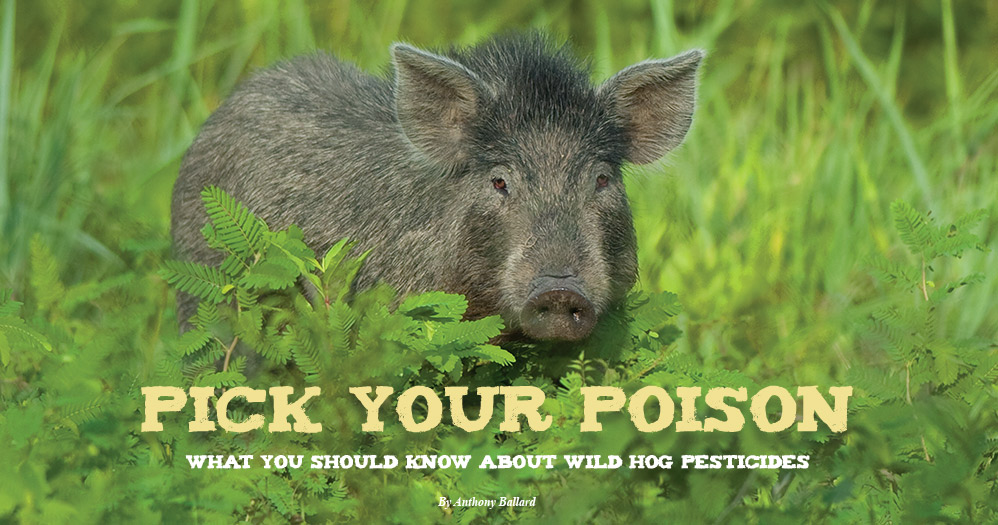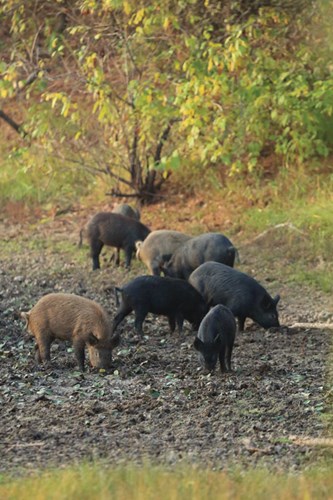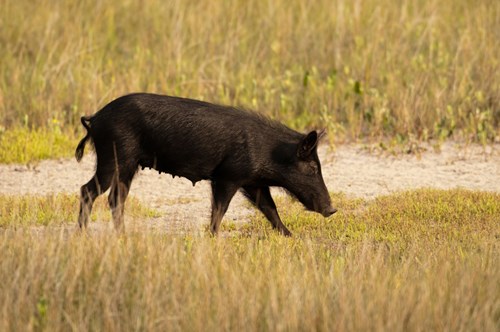
If you have questions about purchasing a license call 1-800-5GO-HUNT.
10/9/2017 9:37:08 AM
MDWFP Nuisance Species Biologist - Anthony Ballard

Mississippi farmers and land managers know the frustration with hog eradication. Recent research by Mississippi State University showed that wild hogs are responsible for $60–70 million in agricultural damages annually in the state.
For years, researchers and biologists have been struggling to develop new strategies to control the stubborn swine. There have been many upgrades to old methods, such as more sophisticated night vision and thermal devices, remotely activated traps with live-feed cameras, and a plethora of new attractants, baits, and feeders. Some of these innovations, particularly in hog trapping, have led to more wild hogs off the landscape. It has been the plea of many, however, to find something new.
History of wild hog pesticides
Since the early 2000s, wild hog pesticide research has been conducted and tested in Australia. Many toxicants were studied and considered as options to control wild hog populations, including sodium nitrite, compound 1080 (sodium flouroacetate), yellow (white) phosphorous, and warfarin. While there was limited success in Australian testing, there were also many problems. Some poisons were banned because of how they caused death in wild hogs, while others were ousted out of concern for non-target animals. In the United States, however, only two substances have been seriously considered to stem the spread of these invaders.
Both sodium nitrite and warfarin have endured controlled testing on wild hogs in hopes of acquiring federal and state approval. While there is currently no substance that can legally be used for the purpose of poisoning wild hogs in the United States, there have been major progressions toward approval earlier this year. In January, the Environmental Protection Agency (EPA) approved a warfarin-based pesticide for registration called Kaput. But federal registration is only the first step in an entire process of approving a product for use outside a controlled facility. After federal registration, each state must decide if the product will be licensed for use within its borders. If approved, a state must then decide what restrictions will be placed upon its use. As with most regulations, the states can be more restrictive than federal law, but not less. Currently, no states have approved the use of any poison for use on wild hogs. So what is the difference between sodium nitrite and warfarin? Quite frankly, everything is different.

Going Kaput
Warfarin, the active ingredient in Kaput, is commonly found in one of two applications: human “blood thinner” medication and rat poison. Like all drugs in the coumarin family, warfarin interferes with the body’s ability to form blood clots. Although safe at appropriate doses, warfarin can cause death in animals that consume large amounts. If enough warfarin is consumed, the slightest abrasion or cut is enough to cause uncontrolled bleeding. At advanced stages of overdose, just the weight of the animal can cause blood vessels in the joints to rupture causing lameness. In the end, death is achieved through excessive internal and external bleeding. The good news is that Kaput contains a blue dye that stains fatty tissue, making poisoned hogs identifiable before human consumption.
Warfarin poisoning in wild hogs relies on a slow accumulation of the drug within the body; therefore, a hog must eat this poison consistently over a period of up to a week to finally cause death. In fact, because of the extended gradual onset of this poison, it was ruled “inhumane” by the Australian government and banned from use on wild hogs.
In addition to the length of time and quantity needed to effectively poison a wild hog, many other concerns exist with the use of Kaput. Though warfarin has been used in rat poisons since the early 1950s, the consequences of using this product in new ways, such as wild hog baits, has not been thoroughly examined. Mississippi is home to many unique species of threatened or endangered animals. The black bear, probably the most widely known species on the list, regularly occurs in much of Mississippi. With its acute sense of smell, a black bear could easily locate and begin consuming this poison. Therefore, a new threat like Kaput on the landscape could present a major roadblock to the recent population progress made by this species.
Not your average salt
If you ate bacon or ham today, you probably had a dose of sodium nitrite. Ironically, sodium nitrite is used as a preservative for pork and other meats. It has also been tested as a toxin for wild hogs.
All animals that circulate blood possess proteins called hemoglobin. Hemoglobin is responsible for carrying oxygen from the lungs to the rest of the body. As with most bodily processes, there is an “on/off” switch used for oxygen transport. Once hemoglobin is oxidized, it relies on an enzyme to remove the oxygen molecule so it can be oxidized again. This process is disrupted during sodium nitrite poisoning. The sodium nitrite interferes with the hemoglobin’s ability to carry oxygen, subsequently causing the animal to suffocate while breathing. Although this process sounds cruel, CO2 inhalation (respiratory acidosis) is a method of euthanasia approved by the American Veterinary Medical Association.
Though not yet federally registered, this poison has shown in testing to be effective and humane. This toxin is also some-what species-specific. Every animal has a fixed amount of the enzyme responsible for reversing the effects of sodium nitrite poisoning. Members of the swine family have particularly low levels of this enzyme, making them much more susceptible to the effects of sodium nitrite than other species. This poison is also not reliant upon consistent and prolonged consumption to obtain results. Instead, wild hogs generally expire within 15–60 minutes after consuming a single lethal dose, bringing a swift and timely death. In addition, if a lethal level is not ingested by the wild hog (or hogs), there are no lasting negative effects on the hog.

Moving forward
As our history can attest, not all pesticides are created equal. We know that some have carried unintended consequences for years or decades, while others turn out to be completely safe and effective. The same will likely be true with wild hog pesticides. The nature of these two poisons lends them different strengths and weaknesses both as a wild hog poison and as a substance that could one day be placed on Mississippi properties.
There are concerns with any pesticides that may be used for wild hog control. Probably the largest issue with applying wild hog bait on the landscape is the delivery system. Obviously, if the apparatus that delivers the poison to hogs cannot exclude the access of other species, it could lead to many unforeseen problems. Secondary exposure is another concern with the application of a wild hog poison. If the substance lingers within the body of a deceased hog, it has the potential to harm scavengers that feed on it. Since wild hogs are often consumed by Mississippi residents, there are human health concerns as well. Health risks due to the consumption of poisoned hogs are low in both types of pesticide (sodium nitrite and warfarin). However, warfarin is known to cause birth defects in pregnant women even in small doses. Another concern with pesticides lies in its environmental impact. A safe pesticide should not pose a substantial risk to any other species of native plants or animals. This is why continued testing and evaluations must be conducted to ensure selective and proper removal of wild hogs.
The Mississippi Department of Wildlife, Fisheries, and Parks (MDWFP) is committed to finding new and effective ways to control the spread of wild hogs, which may eventually include the use of pesticides. Even still, the MDWFP must continue to promote the safe and ethical removal of wild hogs from the landscape without endangering our natural resources. There are a multitude of questions yet to be answered before pesticides can be legalized for use in wild hog management, but with continued research and proper evaluation, it could one day become a reality.
Anthony Ballard is a Nuisance Species Biologist for the MDWFP.